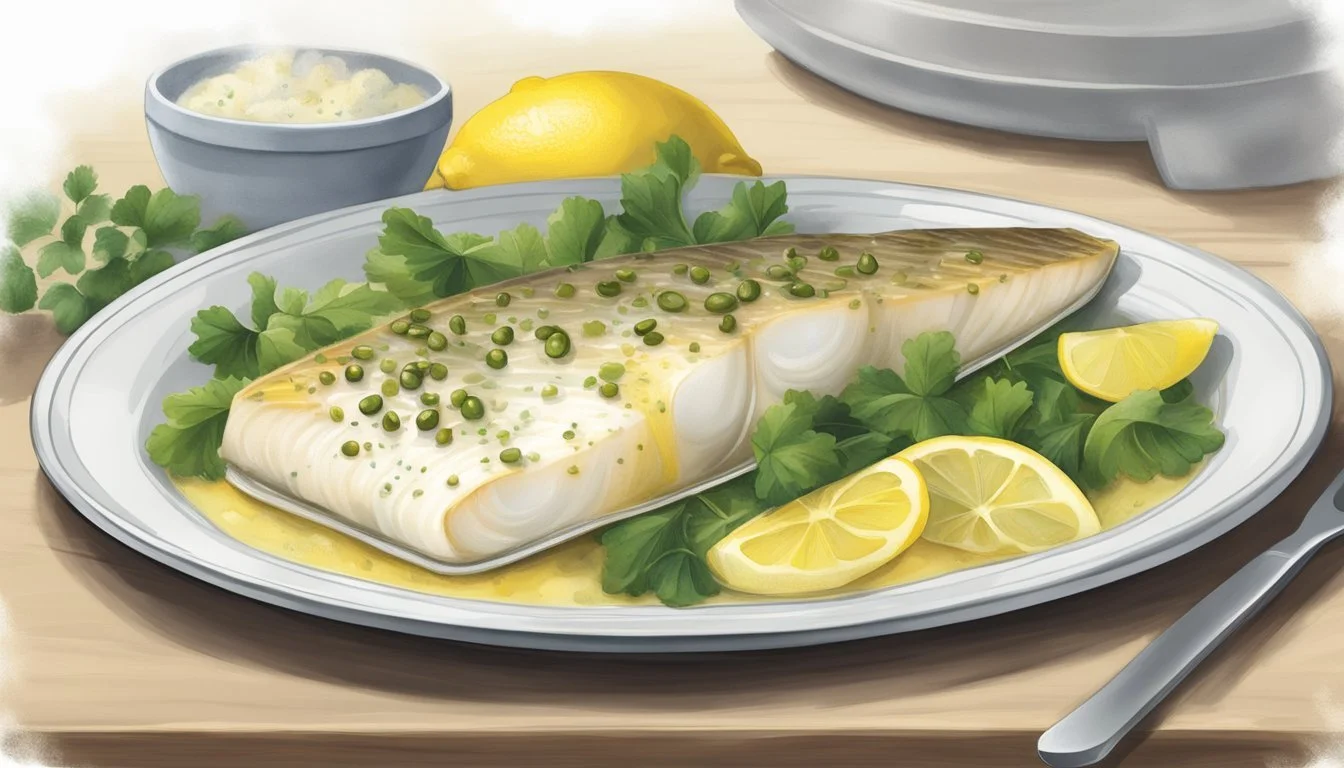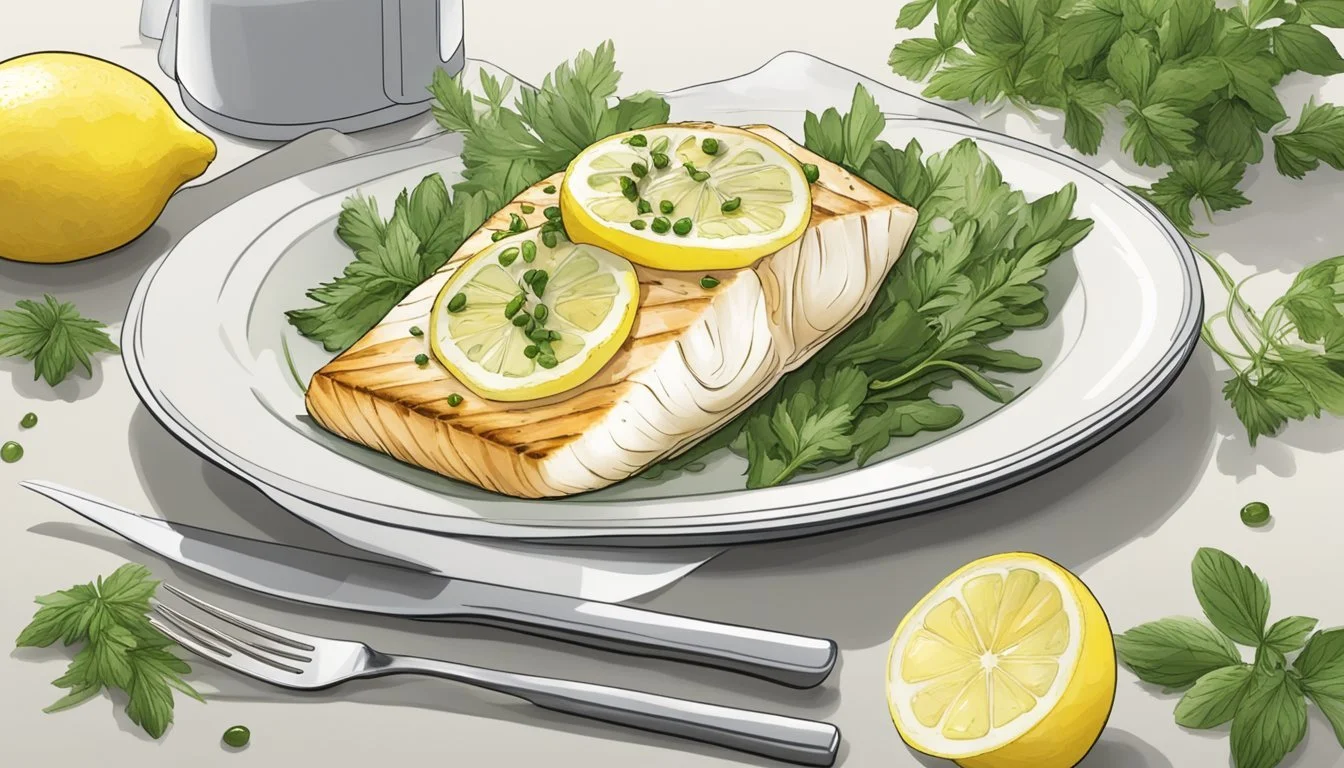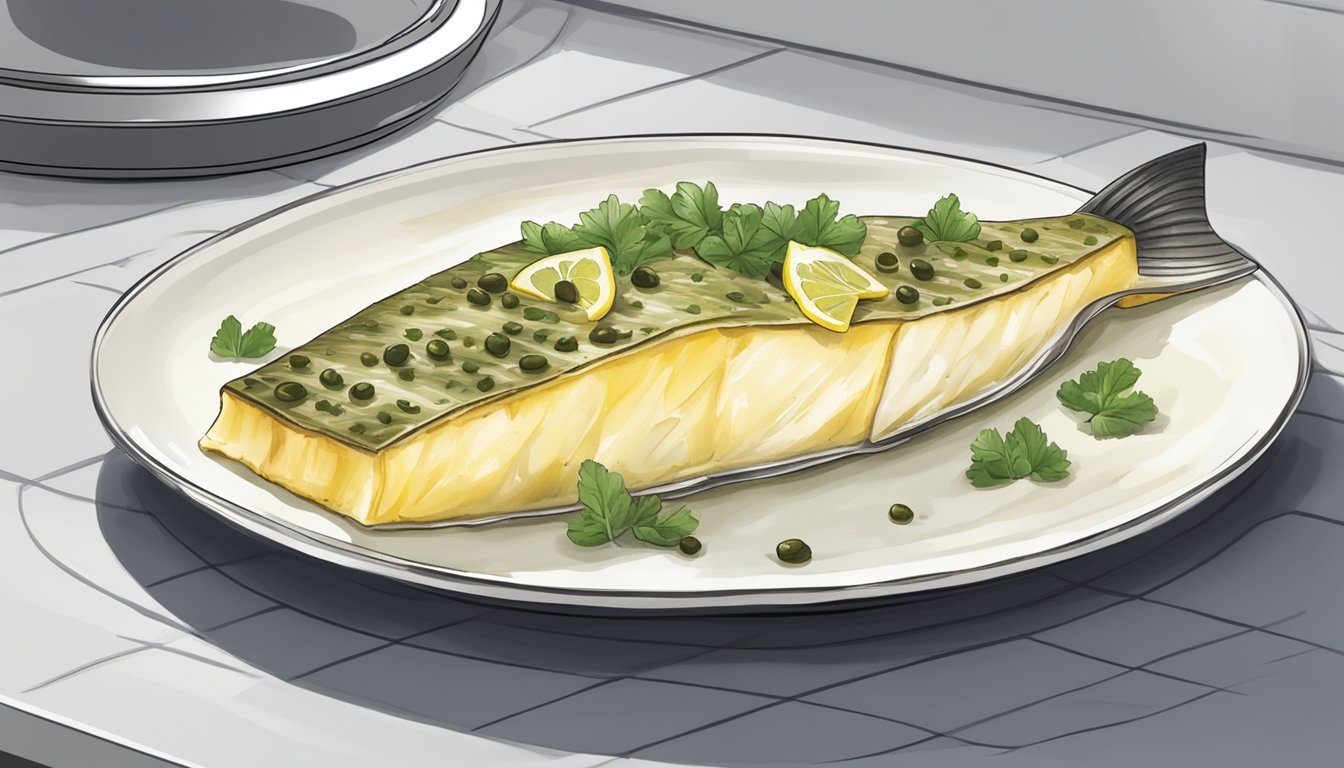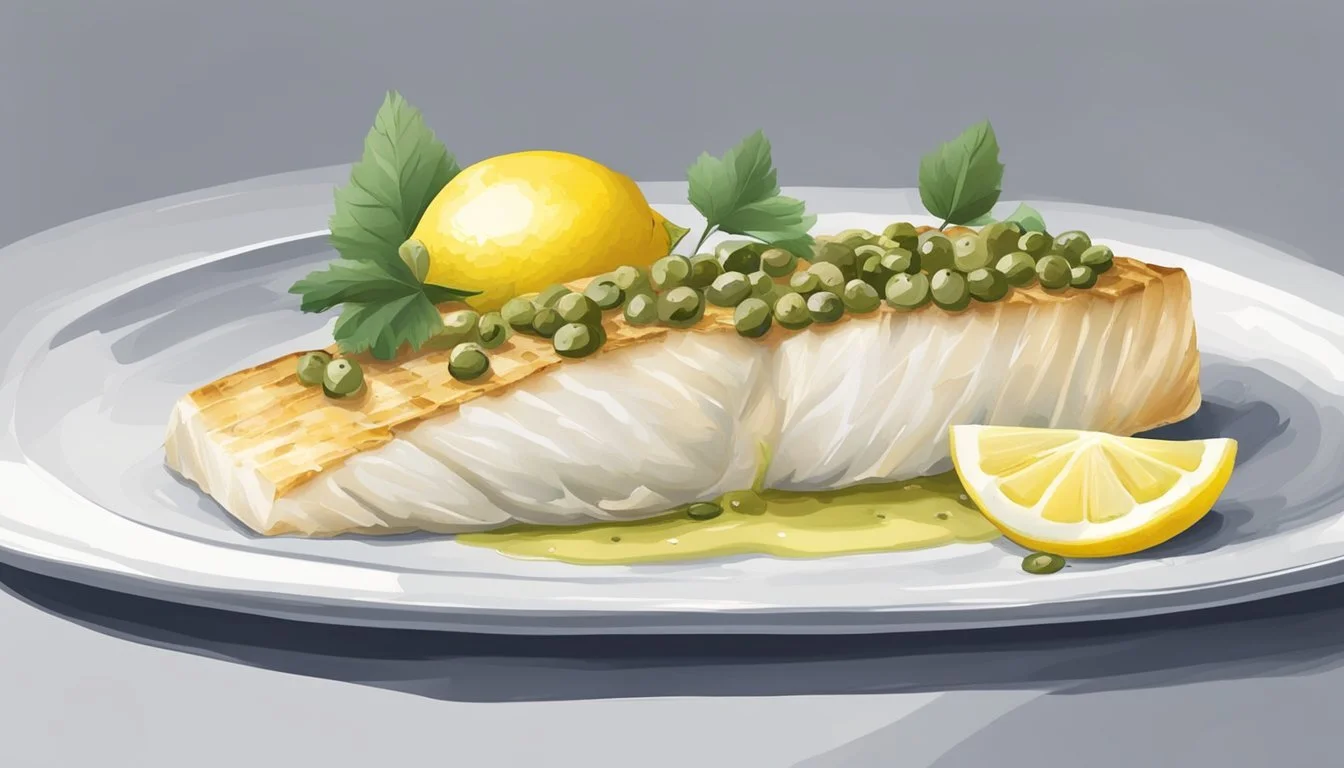Best Way to Reheat Halibut with Lemon Caper Sauce
Ensuring Perfect Flakiness Every Time
Halibut, praised for its mild flavor and flaky texture, can be a culinary delight when cooked properly. However, reheating this delicate fish poses challenges, as the goal is to preserve its moistness and flakiness without drying it out. When accompanied by a lemon caper sauce, the balance of flavors can elevate the dish, but this too requires careful attention to maintain the integrity of the sauce's bright and briny characteristics during the reheating process.
The key to successfully reheating halibut lies in gentle heat and moisture retention. The fish should be warmed in an environment that mimics its original cooking method, using moderate temperatures to gradually raise its internal heat without causing it to lose its succulence. The lemon caper sauce, on the other hand, should be heated separately to ensure it retains its vibrant flavor and does not become overly reduced or separated.
By prioritizing the preservation of both the halibut's texture and the sauce's zest, the reheated dish can rival the freshness of its first serving. Careful technique selections and temperature control are central to this endeavor, ensuring the halibut and lemon caper sauce remain as inviting and satisfying as they were when freshly prepared.
Understanding Halibut
In approaching the culinary nuances of halibut, especially in terms of reheating, one must first recognize its unique characteristics and nutritional value. This understanding sets the stage for better preparation and appreciation of the fish.
Characteristics of Halibut
Halibut is a type of white fish that is well-known for its large size and firm, flaky texture. It belongs to the flatfish family and typically resides in the cold waters of the North Pacific and North Atlantic. Halibut's meaty flesh, which turns opaque and develops a pleasing white color when cooked, is a favorite amongst chefs and home cooks for its versatility and gentle, sweet taste.
Nutritional Profile of Halibut
Halibut is not only favored for its culinary delights but also for its nutritional profile. Being a lean source of protein, it is low in saturated fat and an excellent option for those looking to maintain a balanced diet. Here's a brief breakdown of its nutritional value:
Protein: It provides a high amount of protein, which is essential for muscle building and repair.
Cholesterol: Contains a moderate amount of cholesterol, but can still be part of a healthy diet when consumed in moderation.
Nutritional Info:
Calories: A 3-ounce serving typically has around 115 calories.
Omega-3 Fatty Acids: Rich in omega-3s, contributing to heart and brain health.
Halibut's minimalistic approach to fat content and its dense nutritional benefits make it a wise choice for health-conscious individuals.
Essentials of Lemon Caper Sauce
A great lemon caper sauce balances the brightness of lemon with the briny pop of capers, (What wine goes well with capers?) intertwined with a buttery base and an aromatic lift from fresh herbs. Precision in ingredient choice and understanding their roles will enhance one's ability to create a flavorful and complementary sauce for halibut.
Key Ingredients
Lemon Juice: The central ingredient, providing acidity and brightness.
Capers: Small but impactful, they lend a salty, briny flavor that contrasts with the lemon's tang.
Butter: Gives the sauce richness and helps carry the flavors of other ingredients.
White Wine: Adds depth and helps to balance the sauce's tartness.
Garlic: A crucial aromatic that imparts a savory note to round out the zestiness of the sauce.
Fresh Parsley: A bright, herby element that freshens the palate.
Olive Oil: Often used to begin the sauce, it sets the foundation for sautéing ingredients like garlic.
Flavor Profile
The flavor profile of a lemon caper sauce is marked by multi-dimensional qualities that range from tart and citrusy from the lemon juice, to salty and briny from the capers. The butter adds a layer of richness and smoothness to the sauce, tying together the sharp flavors with its creamy consistency. Meanwhile, white wine introduces a subtle fruity undertone and culinary complexity. Garlic anchors the sauce with a savory earthiness, while fresh parsley infuses a herbal freshness that cuts through the richness. When these flavors combine, they create a sauce that complements the delicate taste of halibut without overpowering it.
Preparation Before Reheating
The success of reheating halibut with lemon caper sauce hinges on proper storage and preparation. These steps ensure that the delicate fish retains its quality and that the sauce's flavors are preserved.
Storing Leftover Halibut
Leftover halibut should be stored promptly after the initial meal to maintain its freshness. Cool the fish to room temperature quickly to prevent bacterial growth. Immediately transfer the halibut into an airtight container. If it is accompanied by lemon caper sauce, one may opt to store the sauce separately to preserve its flavor and to prevent the fish from becoming soggy.
Cooling: No more than 2 hours at room temperature
Containers: Airtight, shallow, and preferably made of glass
Pre-Reheating Steps
Before reheating halibut, it is essential to bring it to room temperature. Remove the halibut from the refrigerator approximately 20 minutes prior to reheating. This step allows for more even heating and reduces the risk of overcooking the edges while the center remains cold.
For the lemon caper sauce, it should be warmed gently to avoid separation. One can utilize a small saucepan and heat it on low, stirring occasionally, until it reaches a suitable temperature.
Halibut Temperature: Room temperature
Sauce Reheating: Low heat, gentle stirring
While the halibut rests, preheat the oven or the skillet, depending on the reheating method chosen, and prepare a non-stick surface using olive oil or parchment paper to prevent sticking and to support the halibut's moisture retention during the reheating process.
Reheating Techniques
When reheating halibut, especially if it is accompanied by a delicate lemon caper sauce, careful attention should ensure the fish maintains its flaky texture. It is crucial to choose a method that gently warms the halibut without drying it out or causing the sauce to separate.
Using the Oven
For a consistent and gentle heat, an oven can be set to a lower temperature, around 325°F (163°C). The halibut should be placed on a baking sheet lined with either parchment paper or aluminum foil. To retain moisture, the fish can be covered loosely with foil. The recommended time is approximately 8-10 minutes per inch of thickness until the halibut is warmed through.
Preheat: Set the oven to 325°F.
Prepare: Place halibut on a lined baking sheet and cover with foil.
Reheat: Bake for 8-10 minutes per inch of thickness.
Pan Searing
For those preferring a more hands-on approach, a non-stick skillet or large cast iron skillet provides control over the reheating process. The skillet should be heated over medium heat with a small amount of butter or oil to prevent sticking. The halibut fillet can then be placed in the pan and covered with a lid. Each side of the halibut should be cooked for about 5 minutes, ensuring it's warmed thoroughly but not overcooked.
Heat: Medium heat with butter or oil.
Cook: Place halibut in skillet, cover, and heat for 5 minutes, flip once.
Microwave Method
Using a microwave is the least preferred method for reheating pan seared halibut with lemon caper sauce as the microwave can unevenly heat and potentially overcook the fish quickly. If necessary, one should use the microwave at a reduced power setting (50%) and heat in short increments of 30 seconds, checking the temperature in between to avoid overheating.
Power: Set microwave to 50%.
Heat: Warm in 30-second bursts, checking frequently.
Each method aims to preserve the original textures and flavors of the fresh halibut and its accompanying sauce, providing an enjoyable dish even after reheating.
Preserving the Texture and Flavor
When reheating halibut with lemon caper sauce, it's crucial to maintain the fish's inherent flakiness while also ensuring that the zestiness of the lemon and the tanginess of the caper flavors are not lost. Both the texture and the flavors complement each other and are essential for the enjoyment of this dish.
Maintaining Flakiness
To preserve the flaky texture of halibut, one should reheat the fish gently. An oven preheated to 325°F (163°C) offers an even and moderate heat that prevents the proteins in the halibut from contracting too rapidly, which can lead to a tough texture.
Reheating Steps:
Line a baking sheet with parchment paper to prevent sticking.
Place the halibut on the prepared sheet.
Cover loosely with aluminum foil to lock in moisture.
Bake for 8-10 minutes per inch of thickness, checking for an internal temperature of 130-135°F to prevent overcooking.
Emphasizing Lemon and Caper
The sharp and briny flavors of lemon and caper are pivotal to this dish. To ensure these flavors remain pronounced:
Handling the Sauce:
If the sauce has separated, gently warm and whisk until emulsified.
Taste the sauce after reheating and adjust the seasoning with additional lemon juice or capers if needed.
For the lemon component, use fresh lemon to brighten the taste, and take care not to overheat it, as the freshness of citrus can deteriorate with excessive cooking. The capers should be added at the end of the reheating process to keep their piquancy intact.
Additional Tips and Tricks
When reheating halibut with lemon caper sauce, maintaining the fish's flaky texture is paramount. The right cookware and seasoning augmentation can greatly influence the final quality.
Choosing the Right Cookware
The choice of cookware affects heat distribution and texture. A cast iron skillet is preferred for its even heating ability and retention. When reheating, the skillet should be warmed slowly to a moderate temperature to avoid overcooking. Using a wooden spoon or a non-metallic spatula can help one safely maneuver the fish without breaking the delicate flakes.
Optimal Seasoning
Seasoning should complement, not overpower, the innate flavors of halibut. A light sprinkle of salt and pepper can be applied to enhance the fish's taste. When dealing with herbs, it is best to opt for fresh over dried for a more intense flavor, adding them toward the end of the reheating process to preserve their aromatics.
Serving Suggestions
When presenting halibut with a vibrant lemon caper sauce, one should consider complementing the dish with sides that enhance the delicate flavors of the fish without overpowering it.
Suitable Side Dishes
Rice: A side of fluffy jasmine rice or a fragrant rice pilaf can be the perfect canvas to absorb the tangy flavors of the lemon caper sauce.
Potatoes: For a heartier accompaniment, herb-roasted potatoes or a creamy mashed potato serve as excellent options.
Presentation Ideas
Lemon Slices: Garnish the plate with thin slices of lemon to reinforce the citrus aspect of the dish.
Fresh Herbs and Parsley: A sprinkle of finely chopped parsley or other fresh herbs adds an appealing touch of green and an aroma that invites one to savor the meal.
Health and Dietary Considerations
When reheating halibut with lemon caper sauce, it's crucial to consider the health and dietary impacts. This section will discuss allergens, dietary restrictions, and how to balance the meal nutritionally.
Allergens and Restrictions
Halibut is a finned fish, which is a common allergen. It's important for those with a fish allergy to avoid this dish. The lemon caper sauce may contain ingredients such as garlic, wine, or butter, which could also pose allergen concerns or not be suitable for certain dietary restrictions. Additionally, individuals managing cholesterol should be mindful of portion sizes, as some fish can be high in cholesterol.
Balancing Your Meal
Protein: Halibut serves as an excellent source of lean protein, important for muscle repair and overall health. When pairing with sides, consider something low in protein to balance the meal.
Nutritional Info:
Calories: Aim for sides that complement the caloric content of the fish without making the meal too heavy.
Macronutrients: A mix of complex carbohydrates and vegetables will offer fiber and essential nutrients.
Ensuring a diverse plate will help maintain a balanced diet while enjoying reheated halibut with lemon caper sauce.
Pairing Wine with Halibut
Choosing the right wine to accompany halibut, especially with a lemon caper sauce, enhances the dining experience by complementing the dish's delicate flavors. The key is to pair wines that mirror the lightness of the fish and the zesty notes of the lemon caper sauce.
White Wine Selections
Chardonnay: For a harmonious match with halibut in lemon butter sauce, a well-balanced Chardonnay is a top contender. The wine's citrus and stone fruit flavors resonate with the tang of the sauce, while buttery undertones underscore the fish's flakiness.
Wine Type Characteristics Sauce Pairing Chardonnay Creamy, Citrusy Lemon Butter Sauce
Sauvignon Blanc: This crisp wine offers vibrant acidity that can cut through the richness of the sauce and highlight halibut's subtle taste.
Wine Type Characteristics Sauce Pairing Sauvignon Blanc Crisp, Acidic Lemon Butter Sauce
Red Wine Alternatives
Although white wines are traditional with fish, certain red wines can be considered when they are light and not too tannic.
Pinot Noir: A light-bodied Pinot Noir with its subtle red fruit flavors and a hint of earthiness can be a delicate companion to halibut, ensuring the fish remains the star.
Wine Type Characteristics Sauce Pairing Pinot Noir Light-bodied, Red Fruits Lemon Butter Sauce
By selecting a wine that complements both the halibut and its accompanying lemon caper sauce, the meal becomes a more complete and enjoyable experience.
Proper Storage After Reheating
Once halibut with lemon caper sauce is reheated, proper storage is crucial to maintain its quality. The texture and flavor can be preserved if the leftovers are stored under optimal conditions.
Refrigeration Guidelines
Temperature: Store leftovers in the refrigerator within two hours of reheating. The temperature should be set at or below 40°F (4°C) to prevent bacterial growth.
Container: Use an airtight container to keep the halibut moist and to prevent it from absorbing other flavors from the refrigerator.
Duration: For best quality, consume refrigerated halibut within 1-2 days. It's important to note that prolonged storage may affect both the texture and taste.
Freezing the Leftovers
Cooling: Ensure the halibut has cooled to room temperature before freezing to avoid condensation and ice crystal formation.
Wrapping: Wrap the halibut tightly in plastic wrap or aluminum foil, then place it into a freezer-safe bag or container.
Freezing Time: Label the container with the date. For optimal quality, use the frozen halibut within 3 months. Extended freezing can alter the halibut's texture.
Thawing: To reheat, thaw the halibut in the refrigerator overnight. Never refreeze halibut that has been thawed and reheated.
Conclusion
In this guide, the focus has been on reheating halibut with lemon caper sauce to preserve its delicate flaky texture, ensuring it remains a delightful main course.
Final Thoughts
For optimal results, reheating fresh halibut should be approached with care. Users should preheat the oven to 325°F (163°C) when warming the halibut. It should be placed on a parchment-lined baking sheet, covered loosely with foil, and heated for about 8-10 minutes per inch of thickness. This method helps retain moisture and prevents overcooking.
Encouraging Experimentation
The reader is encouraged to refer to recipe notes for any specific guidance on reheating their main course. Experimentation with the time uncovered may lead to a desired increase in crispiness, enhancing the dish's texture and flavor profile.









